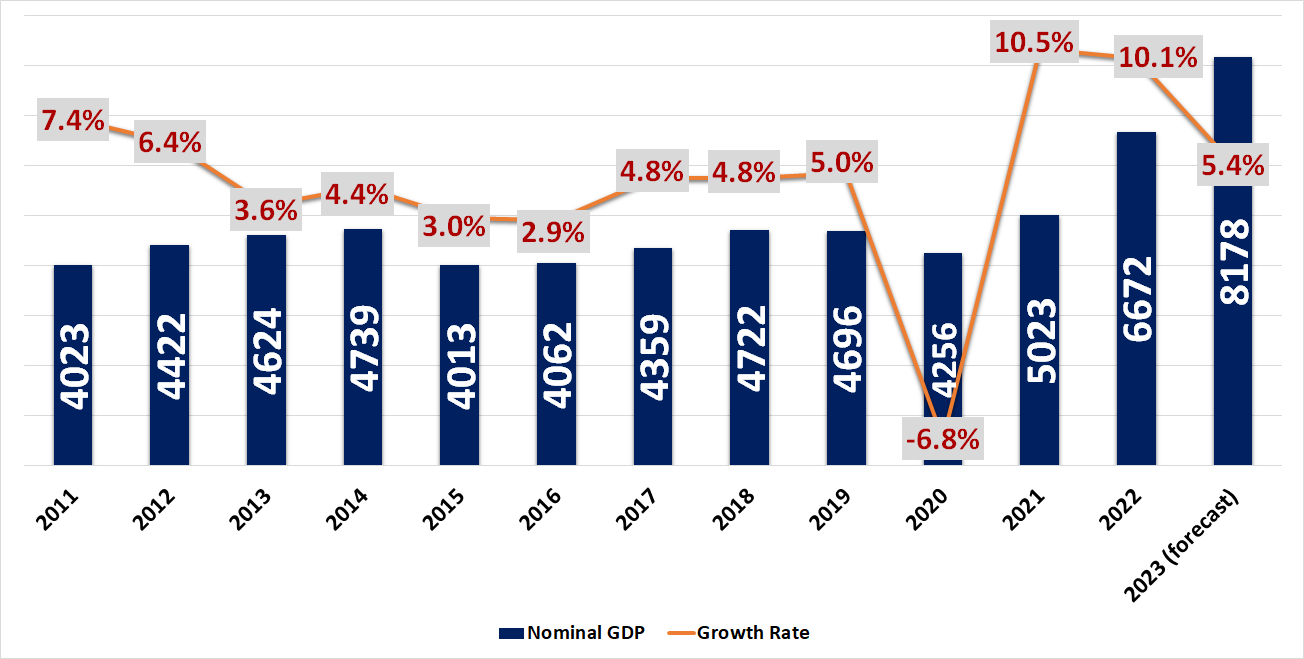Irakli Kobakhidze: “The nominal GDP per capita almost doubled in three years (2020-2023).”
Verdict: FactCheck concludes that Irakli Kobakhidze’s statement is HALF TRUE.
Resume: Irakli Kobakhidze speaks about the nominal economy and this method is not usually used to measure GDP growth between certain periods of time as the nominal economic growth rate exceeds the real economic growth rate because of inflation and does not reflect reality. In addition, the GDP calculation in USD further distorts the picture because of currency rate fluctuations. As a result, growth is shown to be much exaggerated as compared to the real growth figure.
The second factual inaccuracy is about the date. In 2021, the nominal GDP per capita was USD 5,015 whilst the USD 4,250 that the MP mentioned is a figure from 2020.
In 2021-2023 (if the Ministry of Finance’s estimate holds true), the nominal GDP per capita will increase by 63% and the nominal growth rate will be 92% as compared to 2020. However, the real GDP per capita will increase by 16% and 28%, respectively, which means at least three times less growth as compared to the nominal growth figures.
Therefore, on the one hand, Irakli Kobakhidze’s approach is wrong and shows the economic growth rate substantially exaggerated. At the same time, using 2020 as period of comparison – when the economy contracted massively – also contributes to showing exaggerated results which is not clarified in his statement. Although the MP underlined that he is speaking about the nominal GDP, it is doubtful that the term would bring additional clarity for a statistically average listener.
Ultimately, the figures in the statement are basically accurate, although important facts that may create a different impression are ignored. Therefore, FactCheck concludes that the statement is HALF TRUE.
Analysis
On 1 August 2023, the Chairperson of the Georgian Dream, Irakli Kobakhidze, speaking about the economy during his briefing, stated that the USD-calculated nominal economy has doubled in the last three years. In particular, he said: “At the end of this year, Georgia’s economy per capita will reach USD 8,200 whilst the same figure in 2021 was merely USD 4,250. This means that in just three years Georgia’s nominal economy in USD has almost doubled.”
Measuring both the real and the nominal economy is a broadly accepted practice used by Georgia as well as international financial organisations. However, it does have its specific purpose and is not used to measure the GDP growth rate from one particular period of time to another. As a result of inflation and the influence of the exchange rate, the use of the USD-calculated nominal GDP for the evaluation of trends leads to a distorted picture.
It is possible that the nominal economy may grow during a recession, or vice versa – decrease despite real growth owing to inflation and changes in exchange rates. In 2015, the nominal economy in USD contracted by 15% as a result of a sharp depreciation of GEL despite a 3% economic growth. Changes in a person’s well-being are not determined by changes in his income (nominal income) but by its purchasing power to buy more or less products (real income). Therefore, the use of nominal incomes/GDP for a comparison with previous periods is a mistake and does not reflect reality.
Graph 1: Nominal GDP Per Capita (USD) and GDP Growth Rate

Source: National Statistics Office of Georgia
Apart from his use of methodologically erroneous indicators, Irakli Kobakhidze also named an incorrect date. USD 4,250 is not from 2021 but from the pandemic year of 2020. According to the Ministry of Finance’s estimates which are based on a 5.4% economic growth rate forecast, the GDP per capita will reach USD 8,178 in 2023 which is 92% and 63% more as compared to 2020 and 2021, respectively.
As opposed to nominal growth, real growth is much lower and is 16% in 2021-2023 and 28% in 2020-2023. If January-June’s higher than forecasted economic growth rate is maintained until the end of the year, the real economic growth rate in 2023 will be 31% as compared to 2020 - still three times less as compared to the nominal economic growth.
Of additional mention is that 2020 is a less relevant year for comparison because the economy contracted significantly in 2020 owing to the pandemic and the government’s response policy. More appropriate would have been making a comparison with 2019. All things being equal, the lifting of the COVID regulations and the opening of the economy would have definitely been followed by growth and this is something for which the government should not be given credit. As compared to 2019, the real economy will increase by 22% at best in 2023 and only in the case if the higher than forecasted 7.8% economic growth rate is maintained at the end of the year.
Although Irakli Kobakhidze underlined that he was speaking about nominal growth, he did not clarify that this growth was accelerated by inflation and currency exchange rate changes. This creates a certain confusion whose aim is to portray a growth rate higher than it actually is. If we extend the same approach to other periods of time, we will see that the GDP calculated in nominal USD was lower as compared to 2012 whereas Georgia’s real GDP was 23% higher in 2020 as compared to 2012’s figure.
In order to measure how the economy/income per capita has increased from one period of time to another (in a relatively long-term period, given the population changes, it is possible that a country’s economy and income per capita may increase in different percentage) real GDP figures – calculated in local currency constant prices – should be compared to each other or by a multiplication of the GDP annual growth rate difference and the initial and eventual figure. The comparison of the nominal GDP to the past nominal GDP figure in order to measure the economic growth rate is an irrelevant indicator.
Therefore, on the one hand, Irakli Kobakhidze’s approach is wrong and shows a substantially exaggerated economic growth rate. At the same time, using 2020 as period of comparison – when the economy significantly contracted – also contributes to showing exaggerated results which is not clarified in his statement. Although the MP underlined that he speaks about the nominal GDP, it is doubtful that the term would bring additional clarity for a statistically average listener. In addition, even if that is perfectly clear for a listener, the calculation of the nominal GDP has its own purpose and using it to measure the economic growth rate in a continuous period time is not recommended.
Ultimately, figures in the statement are basically accurate, although important facts that may create a different impression are ignored. Therefore, FactCheck concludes that the statement is HALF TRUE.







